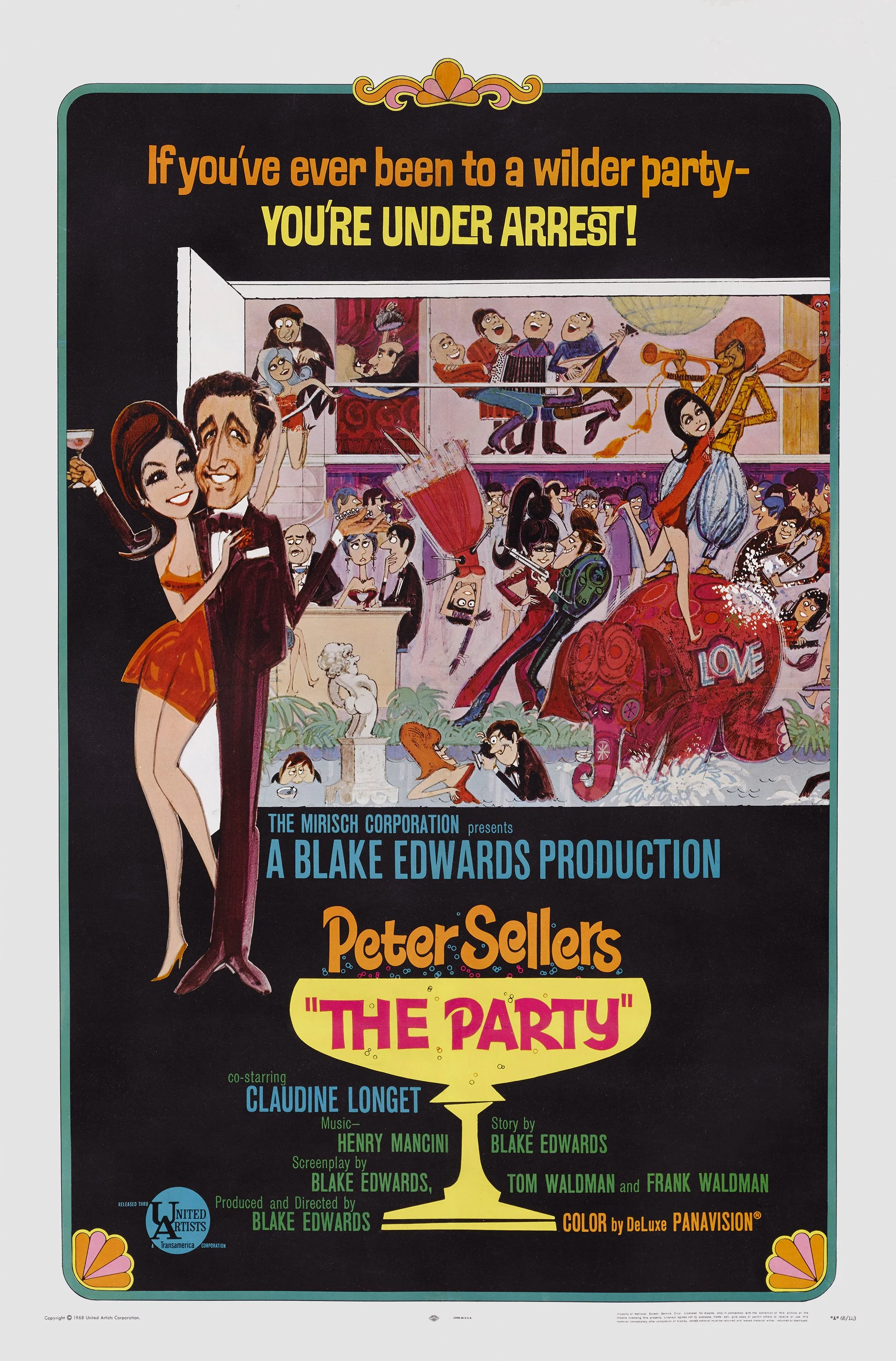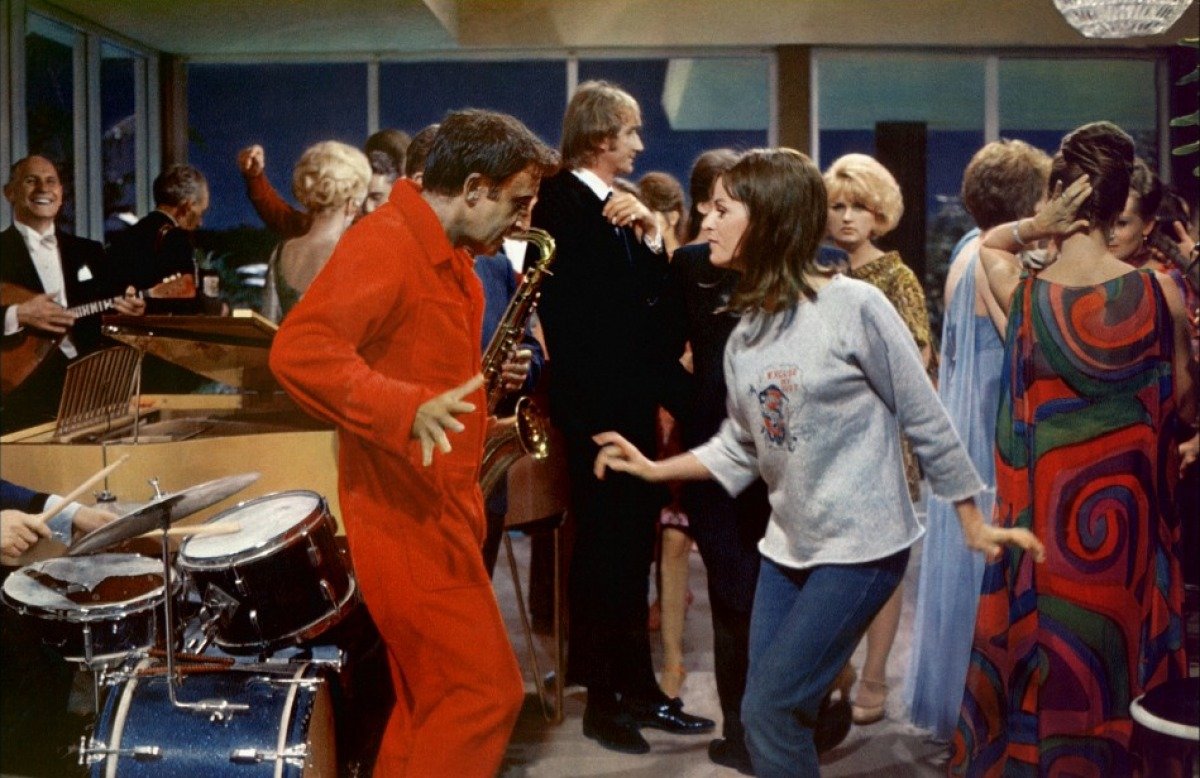Blake Edwards' 1968 Slapstick Masterpiece The Party is an Utter Delight with One HUGE Problem
Directing and acting are largely a matter of choices. The maddening thing about Blake Edwards’ controversial 1968 comedy The Party is that it makes the right choice ALMOST every time.
It’s the closest American film would get to the transcendent slapstick of Jaques Tati but with a populist, gleefully vulgar bent that favors explosive laughter over visual poetry. It’s the only time Blake Edwards and Peter Sellers collaborated outside of the Pink Panther series, and, in my mind at least, it’s better than the Pink Panther films, including A Shot in the Dark.
The vast, ultra-modern mansion where the vast majority of the action takes place is not just a character in itself; it’s one of the best characters of late 1960s cinema. It’s a retro architectural wet dream of the perfect automated house of the future, an almost animistic marvel of cutting-edge technology where anything anyone could possibly want is available at the push of a button. But even the most impressive technology is defenseless before the trouble-making power of a single misguided dope like The Party’s unforgettable protagonist.
Henry Mancini’s score is groovy and far out, the hip, happening sound of the Swinging Sixties. The filmmakers surround their bumbling hero with comic foils who just barely tolerate his bumbling in a way that’s much funnier than responding with the expected apoplectic rage.
There is one choice however, that The Party made that is so off and so wrong that it threatens to undo all of its right and strong choices. Edwards and his gifted collaborators chose to have Sellers play an Indian actor through the sinister magic of dark make-up and a thick accent.
Sellers is rightly considered one of film’s true chameleons, a master of dialects and accents who disappeared into an endless array of wildly dissimilar roles. When he starred in The Party, Sellers had already played an Indian man in the 1960 hit The Millioniaress.
Why shouldn’t he play an Indian man in The Party as well? After all, it’s not as if there were any Indian-American actors. Watching The Party I found myself wishing that I could go back in time and convince Blake Edwards to have Sellers play a gaffe-prone Englishman rather than a man named Hrundi V. Bakshi.
That still would have allowed Sellers to play a foreigner and a consummate outsider without resorting to brownface. But for the purposes of The Party an English Sellers wouldn’t be enough of an outsider. The culture clash wouldn’t be extreme enough.
So the filmmakers decided to give a white man brown skin and in the process needlessly transformed a movie slapstick aficionados should be able to love unconditionally as an apogee of the form into a movie that is deeply problematic and hard to recommend without a whole lot of caveats.
The Party begins with Hrundi working on a big Hollywood production. Sellers’ oblivious cyclone of destruction makes a very big, very negative impression on his new bosses when he accidentally blows up a massive fort when the cameras aren’t rolling.
Hrundi is supposed to be professionally blackballed for squandering the studio’s money. Instead he ends up on the guest list for a big party being thrown by studio head General Fred R. Clutterbuck (J. Edward McKinley).
There’s nothing in the world quite as awkward as going to a party by yourself where you don’t know anybody. The Party captures that excruciating feeling on a painful and painfully hilarious level.
The early scenes at the titular soiree induce a sort of double cringe; we cringe because of the visceral discomfort of Hrundi and the guests he’s good-naturedly terrorizing but we also cringe at the wrongness of Peter Sellers playing an Indian man.
Sellers’ brownface routine induces cognitive dissonance. It’s hard to reconcile the incredible artistry and sophistication of Sellers’ performance, with its humanity, humor and infinite complexity and Edwards’ masterful direction with the regressive, racist trope at the film’s core.
The Party features one of Sellers’ best performances. It’s up there with Dr. Strangelove, Lolita, Being There and the Pink Panther series. That means that it’s also one of the greatest comic turns in film history.
Hrundi is a holy fool but he’s more than that. The partygoers should angrily eject Hrundi for causing a level of destruction on par with a minor war. But they don’t. They cannot help but be charmed, if also annoyed, by Hrundi’s sweetness and child-like enthusiasm.
The fish out of water wins over mountainous cowboy star “Wyoming Bill” Kelso (Denny Miller) through effusive flattery and fandom. He expresses guileless enthusiasm not just for the western star’s work but for seemingly the sum of western entertainment.
There’s a child-like purity to Hrundi, an ingratiating sweetness. Yet it’s also easy to relate to the character’s innate outsiderdom, to his desire to fit into a world he does not begin to understand, and that does not seem particularly interested in understanding him.
Sellers sports a big, disarming smile throughout The Party that has many different connotations, meanings and purposes. On the most basic level, it is a foreigner’s need to illustrate their fundamental harmlessness, to show that they aren’t a danger like the brown-skinned non-Americans racists and opportunistic politicians rave about.
That smile is a thin veneer of civilization and propriety forever stripped away by the innate anarchy in Hrundi’s soul, by his innate compulsion to destroy.
Hrundi has an unconscious collaborator in his unwitting quest to tear down the party from within in the form of the drunkest waiter in the history of film. The waiter grows progressively more inebriated as the evening proceeds and he travels a predictable, hilarious route from tipsy to rip-roaring drunk to a place of intoxication that generally leads to alcohol poisoning and death.
The waiter’s ever-increasing derangement personifies the film’s galloping momentum, its kinetic kookiness, its rollicking ridiculousness. Things just keep getting more and more outrageous as new elements are added to the mix for Hrundi to implement into his symphony of slapstick.
Hrundi is a conductor of chaos, a whirling dervish of comic destruction. The Party is powered less by plot or characterization than by rhythm, energy and momentum.
So it is unsurprising that Edwards finds time for multiple musical performances in the third act as things go joyously out of control and an elephant enters the mix. I’d like to think that at one point in the script an orangutan starting throwing snooty rich people into the pool but they thought that might be a little excessive.
The Party’s lack of simian shenanigans, along with the whole brown face thing, is its only real flaw. Otherwise The Party is a goddamn miracle, a masterpiece of pure physical comedy from two masters operating at the very top of their game.
Would you like to read a massive book full of pieces like this, only shorter? Of COURSE you do! So why don’t you pre-order The Fractured Mirror, the Happy Place’s next book, a 600 page magnum opus about American films about American films, illustrated by the great Felipe Sobreiro over at https://the-fractured-mirror.backerkit.com/hosted_preorders?
The Joy of Trash, the Happy Place’s first non-"Weird Al” Yankovic-themed book is out! And it’s only 16.50, shipping, handling and taxes included, 30 bucks for two books, domestic only!
Buy The Joy of Trash, The Weird Accordion to Al and the The Weird Accordion to Al in both paperback and hardcover and The Weird A-Coloring to Al and The Weird A-Coloring to Al: Colored-In Special Edition signed from me personally (recommended) over at https://www.nathanrabin.com/shop
Or you can buy The Joy of Trash here and The Weird A-Coloring to Al here and The Weird Accordion to Al here
Help ensure a future for the Happy Place during an uncertain era AND get sweet merch by pledging to the site’s Patreon account at https://www.patreon.com/nathanrabinshappyplace We just added a bunch of new tiers and merchandise AND a second daily blog just for patrons!
Alternately you can buy The Weird Accordion to Al, signed, for just 19.50, tax and shipping included, at the https://www.nathanrabin.com/shop or for more, unsigned, from Amazon here.
I make my living exclusively through book sales and Patreon so please support independent media and one man’s dream and kick in a shekel or two!








